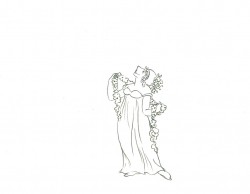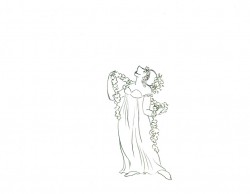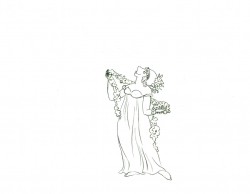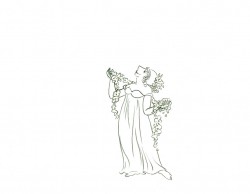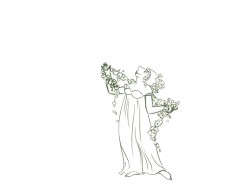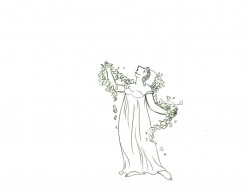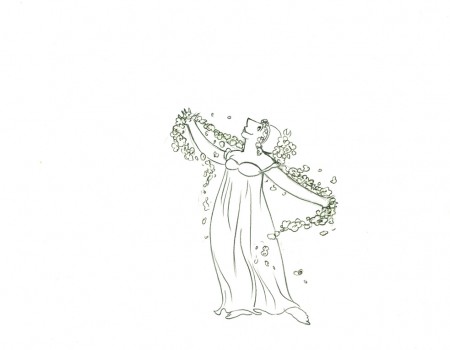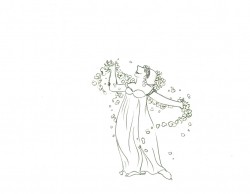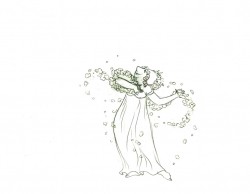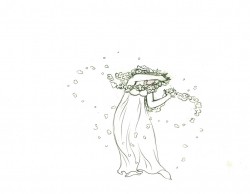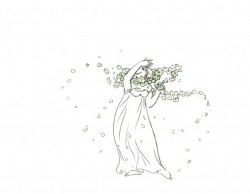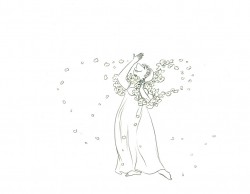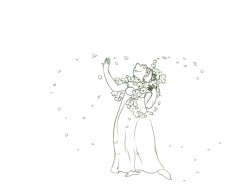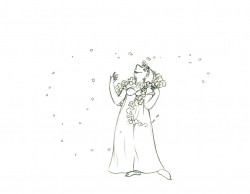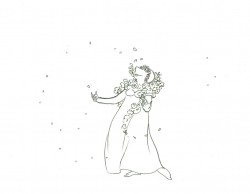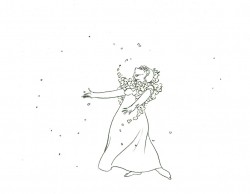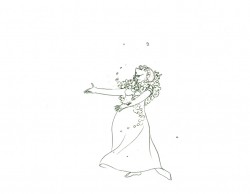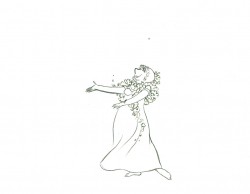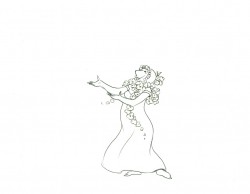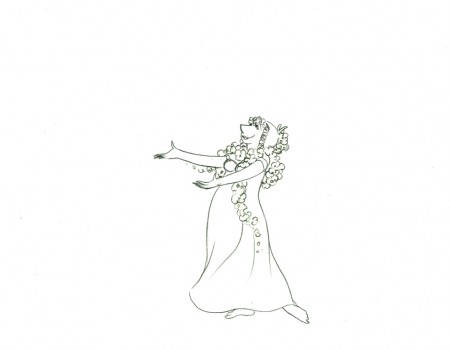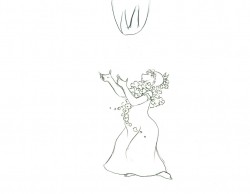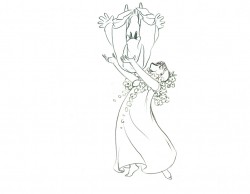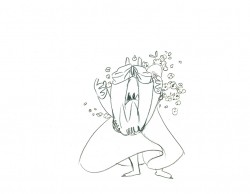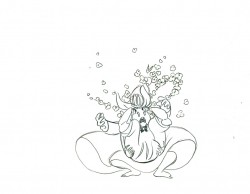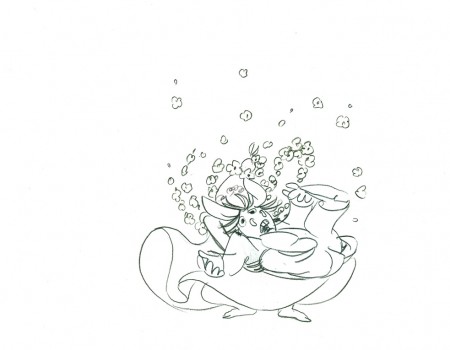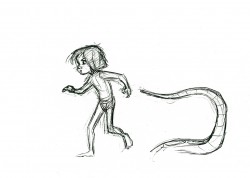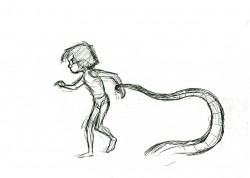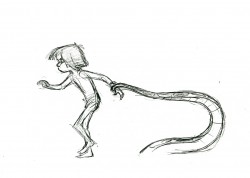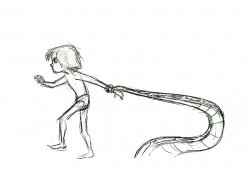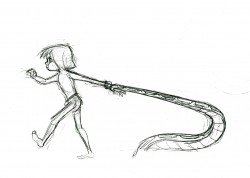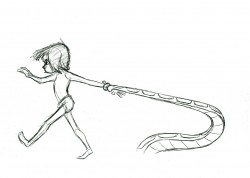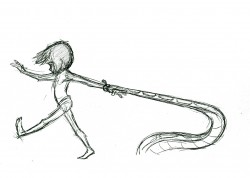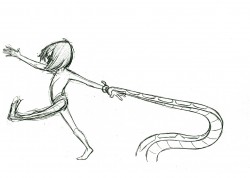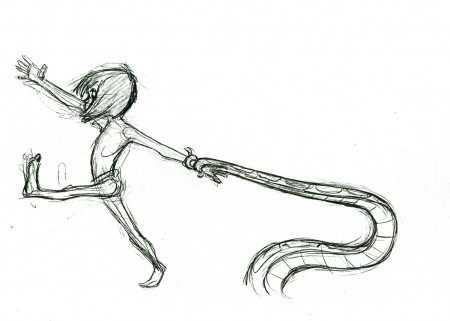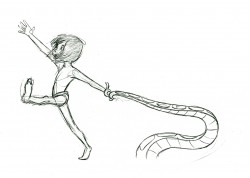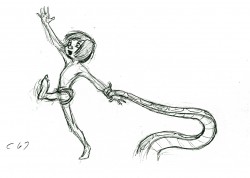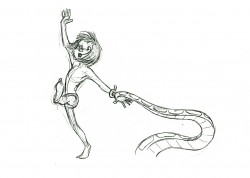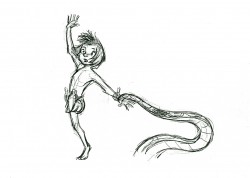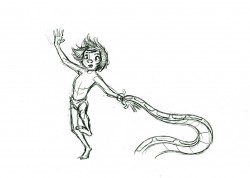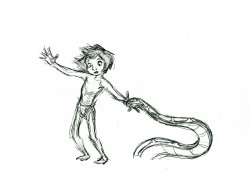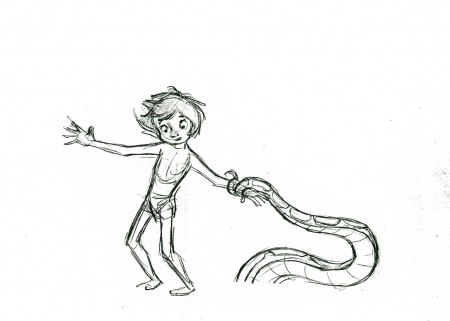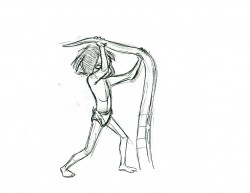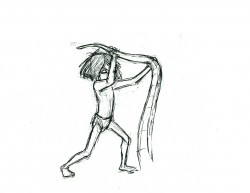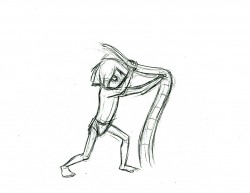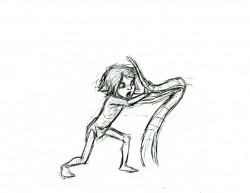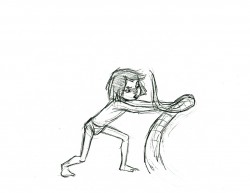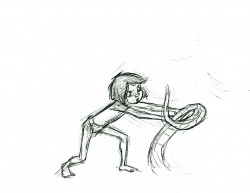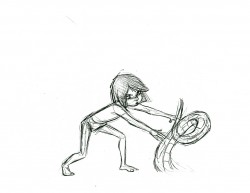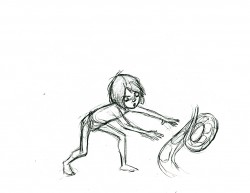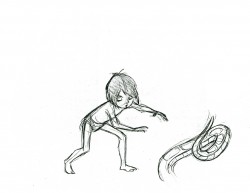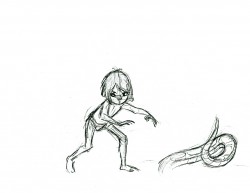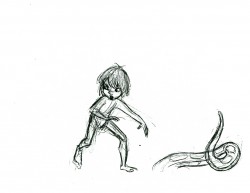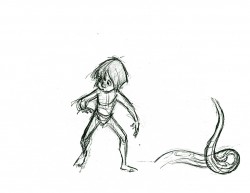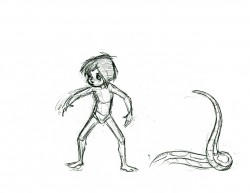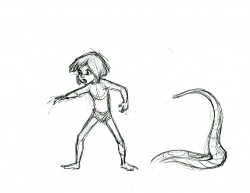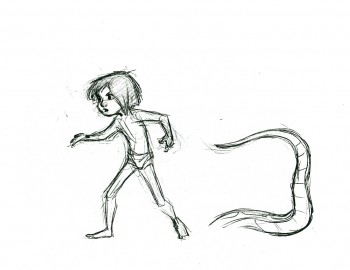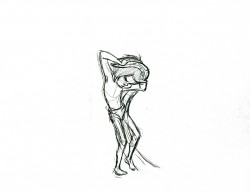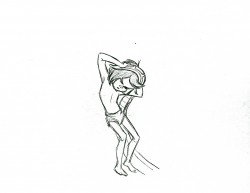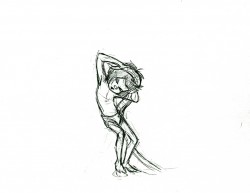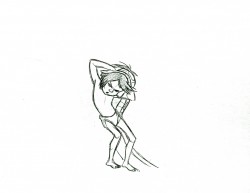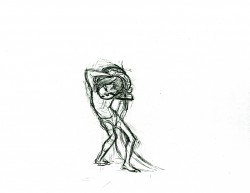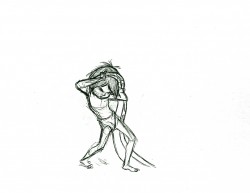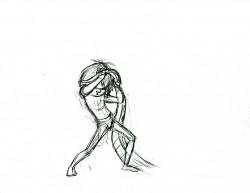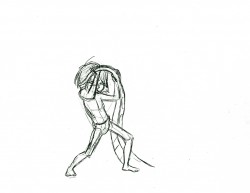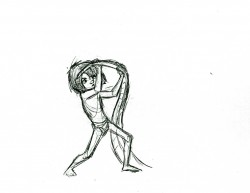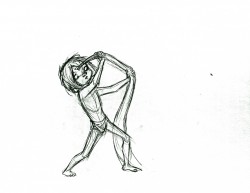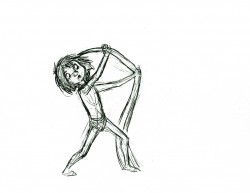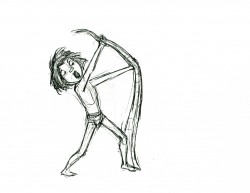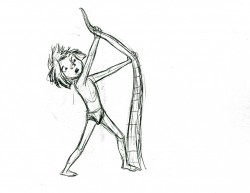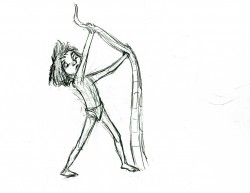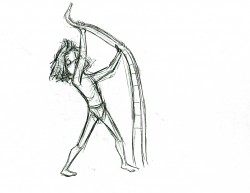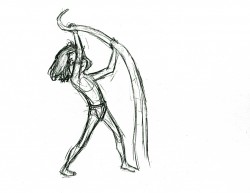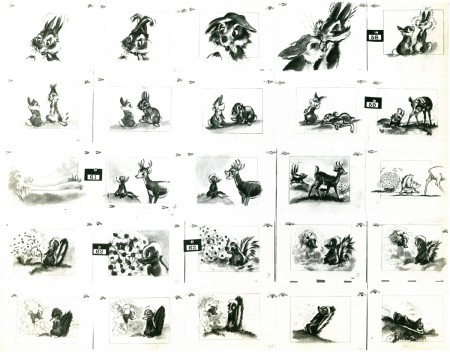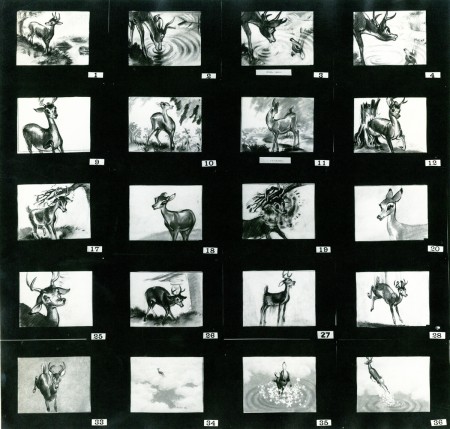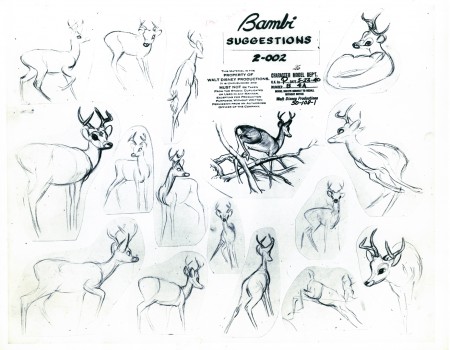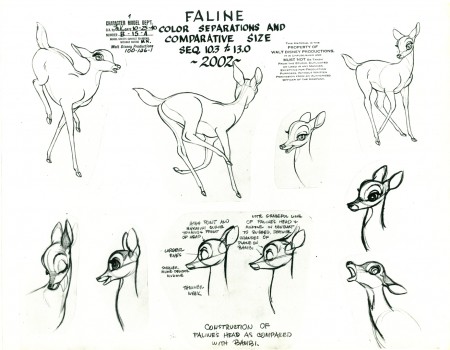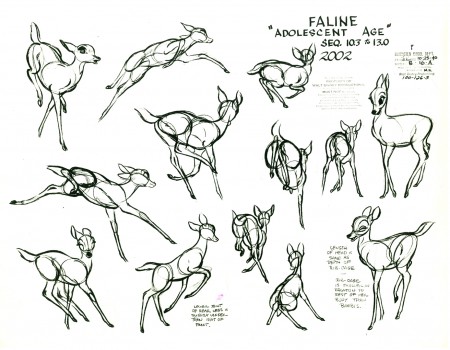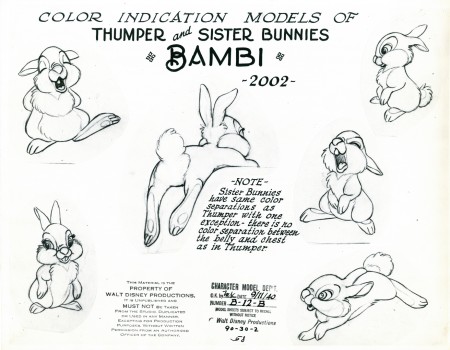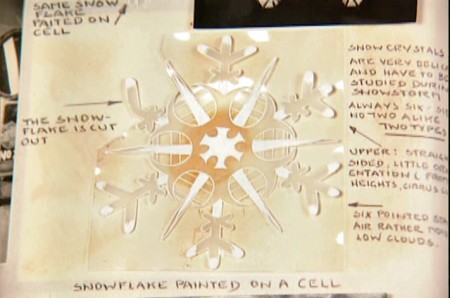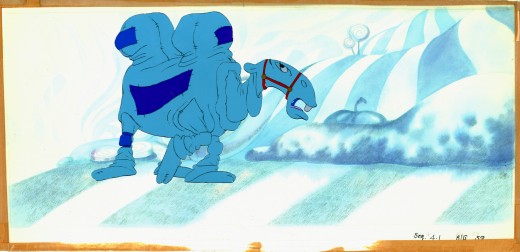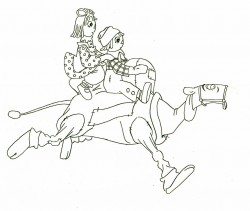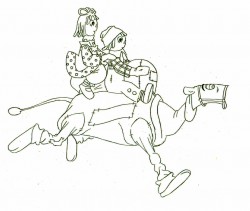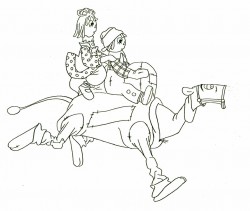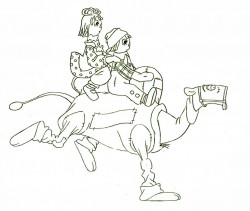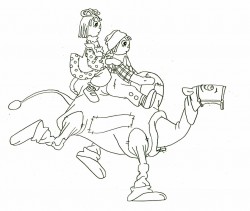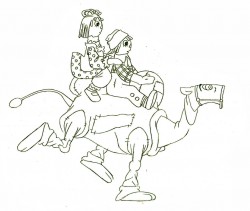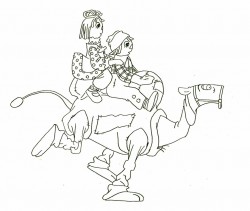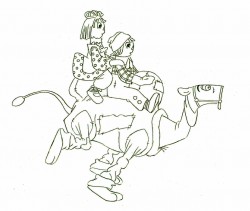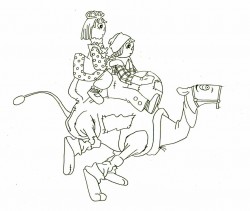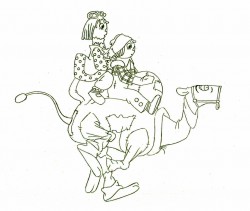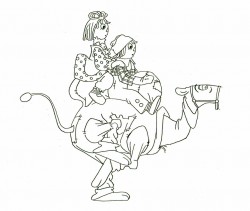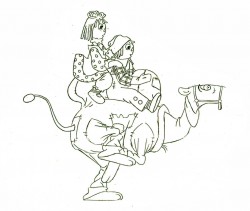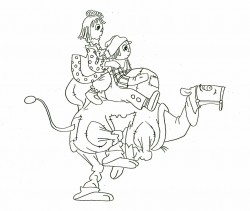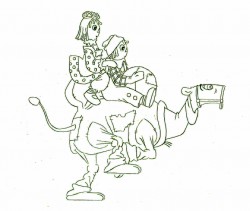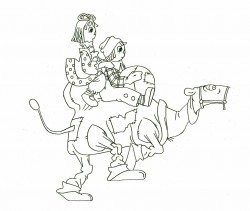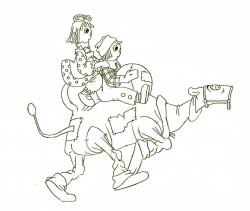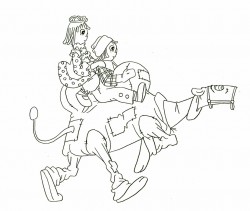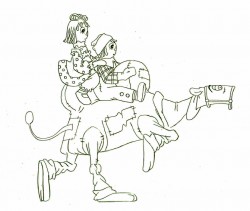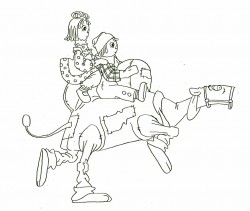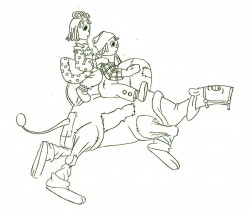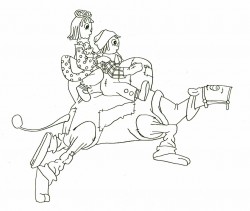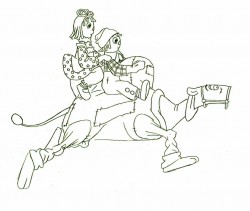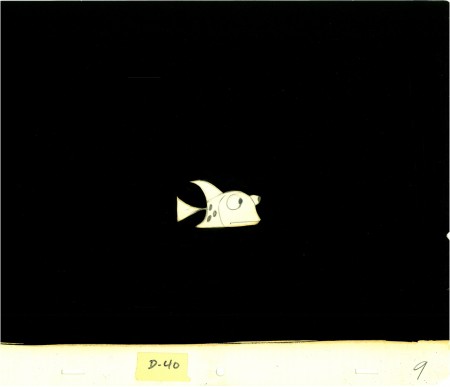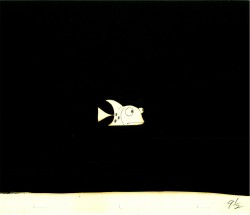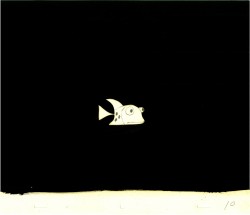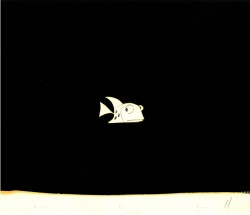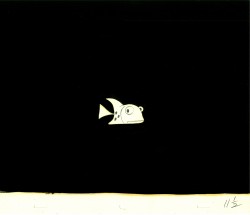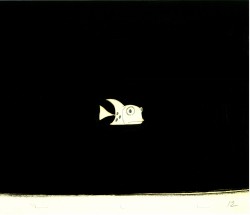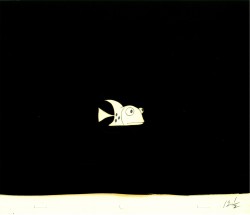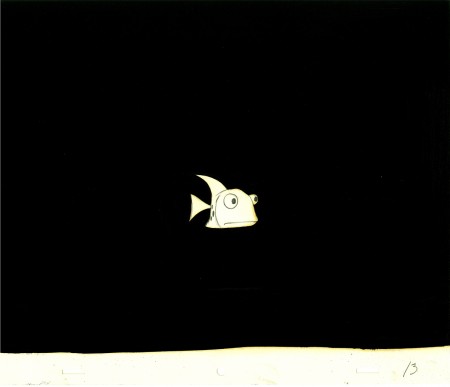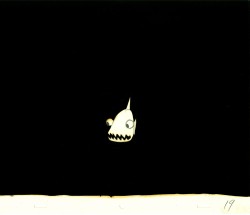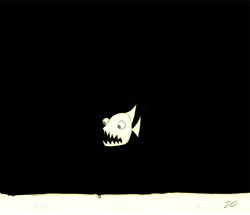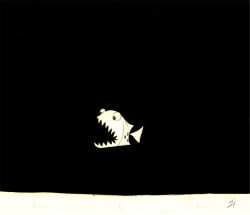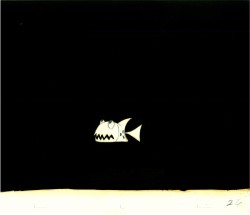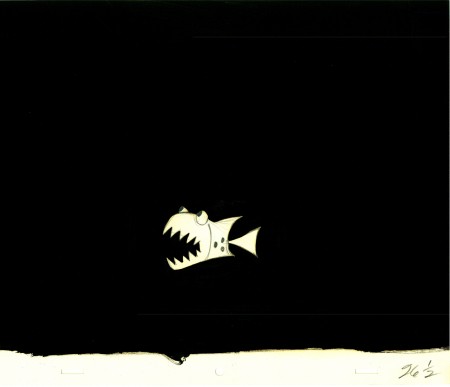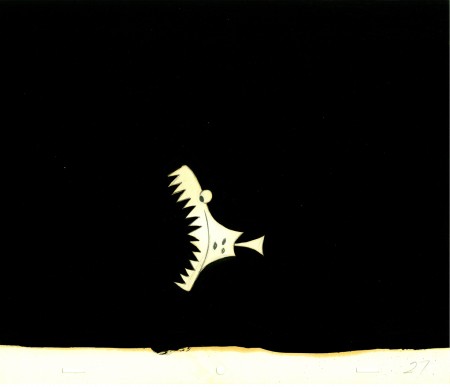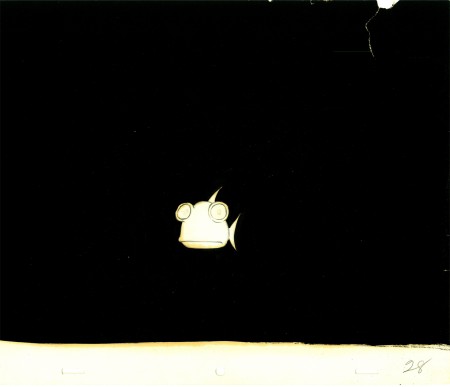Category ArchiveAnimation
Animation &Tissa David 28 Oct 2009 07:23 am
Titania & Bottom 1
- In the past, I’ve done a number of posts about Tissa David‘s work on The Midsummer Night’s Dream. (see them here.) This was a film she directed and animated with three other people: Kalman Kozelka photographed, xeroxed the cels and coordinated it, Ida Kozelka-Mocsary color styled it and did most of the painting, and Richard Fehsl did the Bg designs and animated any of those Bgs.
The film aired on the BBC in 1983 and was released on VHS by Goodtimes Video
I’d previously posted a couple of the cels from a scene, and here I’m posting all the drawings. I do think the film looks better in pencil test, but then I’m partial to Tissa’s beautiful drawing style. Here, again, are those cels:
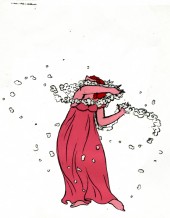
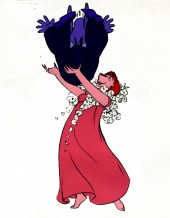
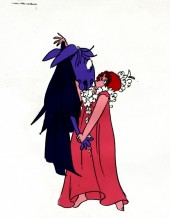
Titania catches Bottom in her arms.
Three cels from a sequence.
And Here are those drawings:
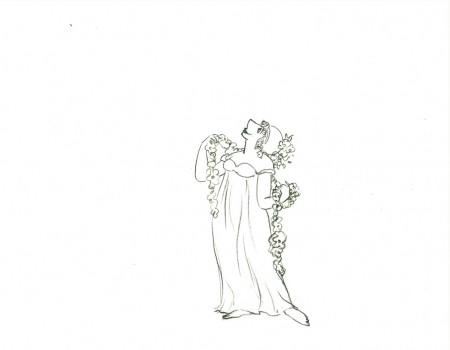 21
21
Titania Dances with Bottom
I took a guess at the timing of this putting the
action on three’s and adding two short holds.
Click left side of the black bar to play.
Right side to watch single frame.
All drawings from the scene (both posts) are in the QT.
Animation &Independent Animation &Layout & Design 23 Oct 2009 07:47 am
Pups of Liberty – Production Art
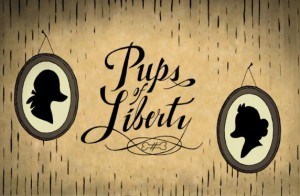 - Yesterday, I posted the first part of a look at a short film, Pups of Liberty. It included an interview with Bert & Jennifer Klein the Producer/Directors (and so much more).
- Yesterday, I posted the first part of a look at a short film, Pups of Liberty. It included an interview with Bert & Jennifer Klein the Producer/Directors (and so much more).
Along with the interview response, they sent me a wealth of gorgeous artwork from various phases of the production, and I’ll try to get most of it in today. The text descriptions, below, are written by their Production Designer, James Lopez.
You can view a trailer from their film here.
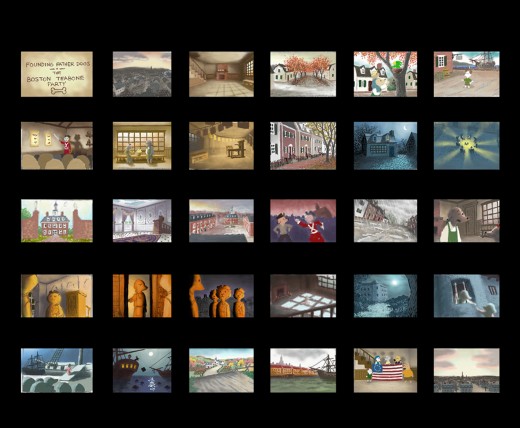
Pups of Liberty Color Script by James Lopez
For the colors, warm colors were chosen to represent the dogs’
surroundings and, in contrast, cool colors to represent the cats.
To start the film, the colors were to portray a pretty town but not
a vibrant one. Only as hope comes alive and tensions run high (The
Boston Tea Party & The Riot) are the more vibrant colors introduced.
Color influences came from some classic Disney films and a desire to
use natural lighting (direct & indirect) as opposed to “staged†lighting.
The story of the movie is left somewhat unconcluded so at the finale,
rather than going full-blown with color, there is a hint at what would be
to come (as the story’s narration suggests).
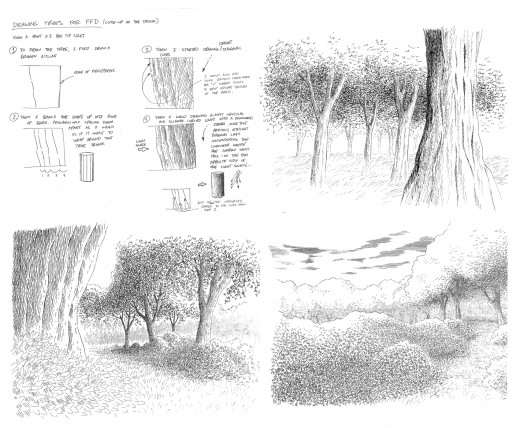
Pups of Liberty - Drawing Trees
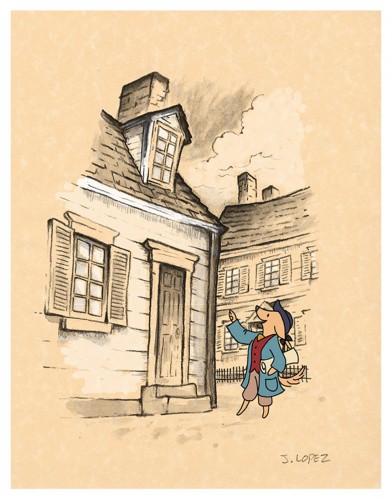
Pups of Liberty - In the style of Anton Pieck
Initally, the backgrounds were going to be influenced by the stylings
of Dutch artist Anton Pieck. Studies were made to see what the style
would look like with a Colonial theme.
A composite was made with the paint study and the character over
a parchment texture. We we were happy with the result of how the
drawn character married into the drawn environment.
It was a nice style but it involved a unique application that was a labor
to produce and proved to be impoprobable so we explored other, more
traditional styles.
We later settled for a pen and ink application on vellum paper in the
rough drawing style of the late Ken Anderson. It allowed us to stay
loose and if there were any mistakes or changes to be made, they
could still be done on paper.
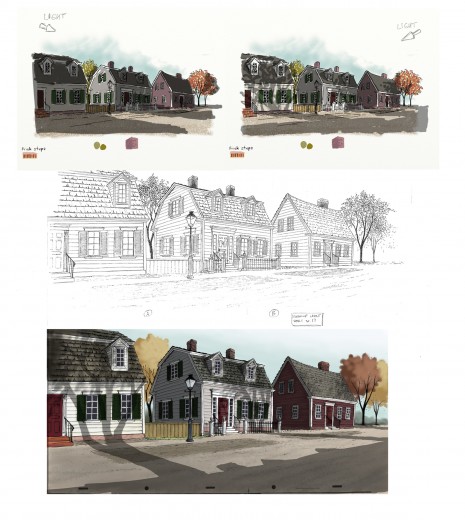
The top two illustrations are visual development for the color and
lighting treatment on the houses. The desired effect was trying to
capture the drama of the shadows cast from the trees by the sun
set low on the horizon.
The middle illustration is a clean-up layout by James Lopez
The bottom illustration is a Production Background painted by James Lopez
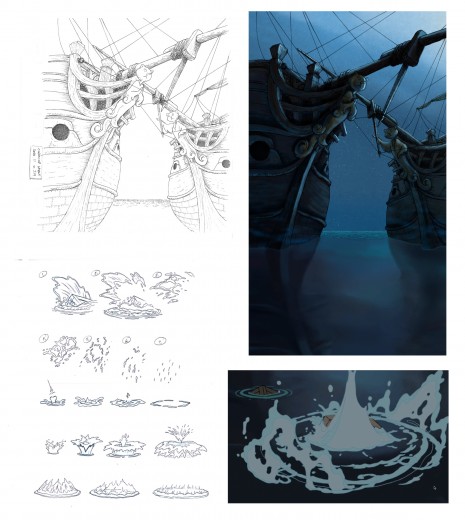
Pups of Liberty - Water Effects
Illustration (upper left) Clean-Up Layout by James Lopez
(upper right) Production Background by Barry Atkinson
(below left) water studies by James Lopez
(below right) Production still
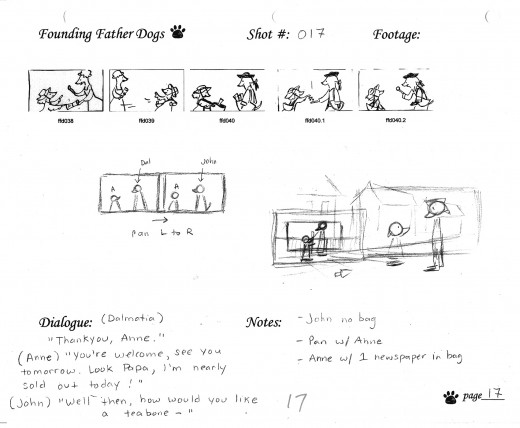
The above images represent a page from the Director’s workbook
for Sc. 17. Storyboard drawings are by Jennifer Klein.
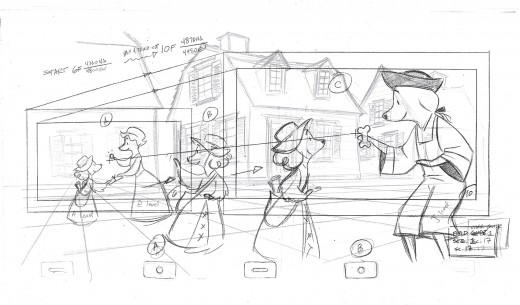
This is the Layout for Scene 17
done by James Lopez.
The QT movies below are Pencil Tests of scenes by
Mark Henn.
Right side to watch single frame.
Animation &Independent Animation 22 Oct 2009 07:53 am
Pups of Liberty – Interview
- I’m an Independent Director/Animator/Producer of animated films. As such I watch closely what else is going on independently in the world of animation. I try to keep up with most of the short films made and being made; I try to keep up with all the people involved in that world.
 In the old days, one had to go to the Festivals around the world to see these films. ASIFA East often brought some of these films and filmmakers to our local meetings, but generally you had to travel to see the average film. The big, famous award winners would always show up somewhere. Nowadays, the Internet has brought more films and artists into my life, and I get to see more of the less than sterling flms from around the world. Ian Lumsden’s Animation Blog has introduced me to many films I wouldn’t have even known to look for including many gems. Niffiwan‘s Animatsiya in English brings Russian films that would otherwise escape my notice. There’s a lot out there, and I keep looking.
In the old days, one had to go to the Festivals around the world to see these films. ASIFA East often brought some of these films and filmmakers to our local meetings, but generally you had to travel to see the average film. The big, famous award winners would always show up somewhere. Nowadays, the Internet has brought more films and artists into my life, and I get to see more of the less than sterling flms from around the world. Ian Lumsden’s Animation Blog has introduced me to many films I wouldn’t have even known to look for including many gems. Niffiwan‘s Animatsiya in English brings Russian films that would otherwise escape my notice. There’s a lot out there, and I keep looking.
The fortune of having a modestly successful blog is that some filmmakers actually approach me. Such was the case with Jennifer & Bert Klein‘s Pups of Liberty. They sent me a link to their site which offered a trailer for their short film, and they offered to send me a DVD of the entire film.
When I looked at their site and trailer, it was obvious this wasn’t your average short. I saw the very full animation, beautiful backgrounds, and I looked deeper.
I saw the credit list and the names of James Lopez (Animator on Hercules, Emperor’s New Groove, Flushed Away and Princess and the Frog), Eric Goldberg (Animator on Aladdin, Fantasia 2000, and Princess and the Frog), Barry Atkinson (BG artist on Prince of Egypt, American Tail and The Lion King), and Mark Henn (Animator Ariel, Belle, Jasmine, Mulan and Tiana) among others. I had to see this film.
I wasn’t disappointed. The animation is sterling in the richest of full animation; the Bg’s are beautifully styled to feel like the period (the Revolutionary War) they’re meant to suggest, and the Direction couldn’t be cleaner or clearer or more focused. The film doesn’t waste a shot, but drives itself through the story in a very economical approach. Yet not a dollar seems to have been spared in making this the extraordinarily lush film it is.
I had to respond to Jennifer and Bert Klein to ask for a short interview and they responded with answers to any question I posed and plenty of supportive material. Hence, I’ll post that Q&A today with some stills from the film, and tomorrow some amazingly attractive pre-production artwork. This film deserves a book of its own.
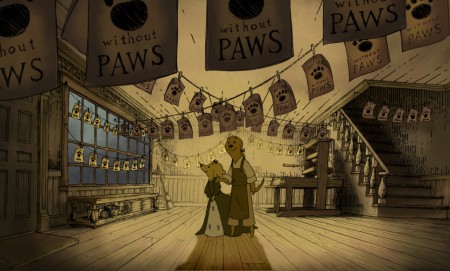
All images copyright © 2009 Picnic Productions
The Interview
Michael – What prompted you to develop this story? It reminds me a bit of Disney’s Johnny Tremaine in the way that it focuses on a particular craftsman and his daughter, just as the live action film focused on a silversmith and his apprentice. Was there any inspiration from that film/book? Animation wise, it feels a bit like Ben & Me. Perhaps that’s because of the subject.
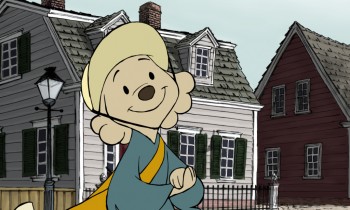 Jennifer – I have always loved this era of history (Colonial/Revolutionary America) so when I first began developing an idea for a new short it was the first setting that came to my mind. I wanted to make a story that was quality and that a viewer would feel good about watching; I was also very interested in how to teach people concepts (like taxation and representative government) with a media like animation.
Jennifer – I have always loved this era of history (Colonial/Revolutionary America) so when I first began developing an idea for a new short it was the first setting that came to my mind. I wanted to make a story that was quality and that a viewer would feel good about watching; I was also very interested in how to teach people concepts (like taxation and representative government) with a media like animation.
The story of the Boston Tea Party seemed like an iconic event to start with, since most American school kids learn about it pretty early on. The more I researched the more I was drawn to the story of the printer who started the Sons of Liberty. I love the idea of a group of ordinary people getting together to motivate change in their world, and I liked that that is something that translates internationally, to everyone.
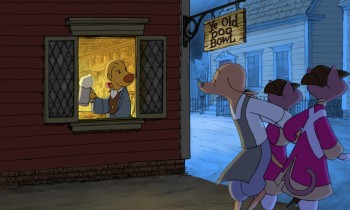 I grew up watching Robin Hood because it was the only Disney movie we had. At some point I saw Ben and Me and I have always liked that one a lot too. I like allegorical story telling, fables… so it seemed natural to tell the story with animals. In a way it lightens up the mood of it having a political bent- because really, they are talking dogs and cats.
I grew up watching Robin Hood because it was the only Disney movie we had. At some point I saw Ben and Me and I have always liked that one a lot too. I like allegorical story telling, fables… so it seemed natural to tell the story with animals. In a way it lightens up the mood of it having a political bent- because really, they are talking dogs and cats.
Bert – We initially considered making a film about the first Thanksgiving with cats as pilgrims and birds as the native Americans. We moved ahead in time a bit and did the Boston Tea Party instead.
I’m sure you don’t want to discuss your budget, but you must have gotten a lot of incredibly talented people to volunteer to help you make the film. (Eric Goldberg, Mark Henn et al). The expense easily looks quite high.
Michael - Was the budget completely out of pocket?
- How did you create such enthusiasm for the project to do so?
- Now that you’ve finished what is your hope for distribution or future development?
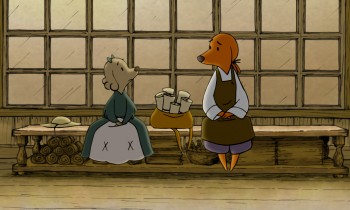 Jennifer – Our budget was all out of our own pocket. We might be a little crazy I guess, but this is what we do. It’s our hobby. Bert and I are very passionate about making shorts, and when we began the project we were also very interested in keeping ourselves in practice for 2d animation at a time when there weren’t any other 2d features being made at any of the studios. Our friends who worked traditionally started to hear about the film and we would have evenings with everyone over and do pencil tests and see them cut into the storyreel – and we’d always have pie, I would bake every night for the crew. The nights started to take on a family atmosphere, and I think everyone felt very comfortable to come and practice their art that they had been trained to do. Everyone was working at their highest skill level– Mark Henn was doing 20 feet a week, James Lopez stretched himself and all of our layouts, we had cleanup people doing the most beautiful work I had ever seen from them. I can’t say how we “created” enthusiasm because you can’t consciously create something like this. You’re just darned lucky that it happens.
Jennifer – Our budget was all out of our own pocket. We might be a little crazy I guess, but this is what we do. It’s our hobby. Bert and I are very passionate about making shorts, and when we began the project we were also very interested in keeping ourselves in practice for 2d animation at a time when there weren’t any other 2d features being made at any of the studios. Our friends who worked traditionally started to hear about the film and we would have evenings with everyone over and do pencil tests and see them cut into the storyreel – and we’d always have pie, I would bake every night for the crew. The nights started to take on a family atmosphere, and I think everyone felt very comfortable to come and practice their art that they had been trained to do. Everyone was working at their highest skill level– Mark Henn was doing 20 feet a week, James Lopez stretched himself and all of our layouts, we had cleanup people doing the most beautiful work I had ever seen from them. I can’t say how we “created” enthusiasm because you can’t consciously create something like this. You’re just darned lucky that it happens.
We are submitting the Pups to film festivals, so we will have about 2 years worth of that, and then we’ll see what happens. My biggest hope would be for a series. I would also love to see it in the classroom one day.
Michael – It must have taken quite some time since I doubt you were able to work steadily on the film and had to fit it in between other jobs. (I’ve seen your resume and know you’ve been busy outside of this film.)
- How long did it take to make, given your work schedule?
- How were you able to maintain such a consistent (and consistently high level) look while working on it on a long, piecemeal schedule? (Assuming that was the case?)
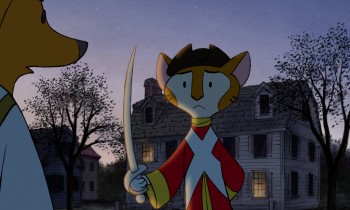 Bert – Most of the production took place during spare time over a two year period. The births of our two kids stretched out the last bits almost another two years.
Bert – Most of the production took place during spare time over a two year period. The births of our two kids stretched out the last bits almost another two years.
One way we ensured consistency was having Jennifer do clean up keys over the different animators’ drawings to maintain the style. Mark Henn did a lot of animation on the film and helped raise the bar for everyone else. One person (James Lopez who was a supervising animator at Disney for a decade) did all of the layouts. I animated a lot of it myself and just kept working on it until it was done. Our assistant director Hyun-Min Lee was invaluable to us in getting this done, tackling technical problems, organizing scenes and x-sheets, and trackreading amongst many other jobs.
Jennifer – I took some time off to work on the film, so I was able to dedicate all of my time to it. I did the boards, designed the characters, did reds for the cleanup keys. I think that the simplicity of the characters saved us a lot of line mileage and made it possible for the artists to get through the footage quickly. They also look best against the backgrounds, which are done in a hand drawn pen-and-ink style and required something simple to contrast with them. We looked at the printwork from the time for inspiration- Paul Revere’s engravings especially really had a ‘homemade’ colonial feel, and you can see his personality in them and in the brush strokes of color used that we tried to invoke.
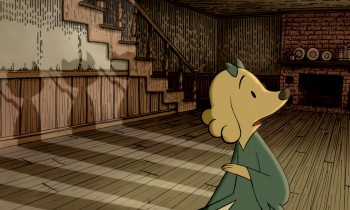 It is hard to sit down and work after you have worked a full day, but I always remembered something Bert would say- “Even if you just get one drawing done you are one drawing ahead.” So I’d try and get one scene’s worth of layouts done a night, or read a track, or just something, and we’d inch forward until we were done.
It is hard to sit down and work after you have worked a full day, but I always remembered something Bert would say- “Even if you just get one drawing done you are one drawing ahead.” So I’d try and get one scene’s worth of layouts done a night, or read a track, or just something, and we’d inch forward until we were done.
Michael – Just as American Tail was compared to MAUS, your film has already received a comment on Cartoon Brew comparing it. There are very obvious differences, but I wonder if you thought about this possibility?
- Or worried about it?
- Did you ever question the idea of doing it with humans?
- Or would that have made you focus even more on historical accuracy?
Bert – I heard of MAUS, but I’ve never read it. Our main reason to make this was purely a labor of love. I watched Jennifer do great work as a story artist on lots of feature projects for studios that never got made or changed radically from the first inception. She was one of the original story artists on Where the Wild Things Are when it was a fully animated feature back in 2001. I wanted to produce a film that was a showcase for her story sensibilities because I felt that it might be the only way to get that pure vision to the screen. We also hope that people and their kids can enjoy it.
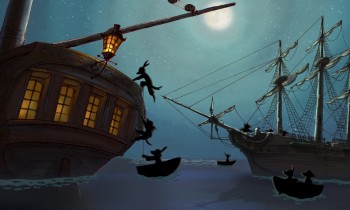 Jennifer – Honestly I never heard of Maus. Whatever subject matter you make a film about though, there will always be something to compare it to — how many films are there about aliens? Or zoo animals? A setting is just a setting- it’s how you hook the audience in, how you make them really feel for and believe in your characters, and the experience that you give them that matters.
Jennifer – Honestly I never heard of Maus. Whatever subject matter you make a film about though, there will always be something to compare it to — how many films are there about aliens? Or zoo animals? A setting is just a setting- it’s how you hook the audience in, how you make them really feel for and believe in your characters, and the experience that you give them that matters.
Doing a historical film with humans instantly makes it more serious- doing it with animals, you can’t take it as seriously and you can have more fun with it. Why animate humans when you can animate talking dogs? It made us laugh. We did it this way so that we could have some fun, and do what we love to do.
Animation &Animation Artifacts &Disney 19 Oct 2009 07:37 am
Frank Thomas’ Jungle Book 3
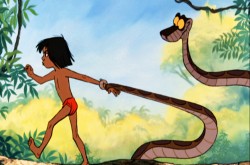 - This is the last of three posts showcasing the drawings of Frank Thomas for one scene of Mowgli and Kaa in The Jungle Book.
- This is the last of three posts showcasing the drawings of Frank Thomas for one scene of Mowgli and Kaa in The Jungle Book.
Frank was a very productive animator who was very defensive of his drawing ability, yet he always seemed to come up with something attractive and full of his gentle personality.
There is some nice use of foreshortening in the leg of Mowgli in these drawings. You have to be particularly good at drawing to make it work; I think I’ve seen too many bad drawings where it’s called attention to itself. Foreshortening is usually something worth avoiding unless you feel really confident about it. However, as done by Frank, it really helps the motion.
Again there is a smart use of ones and twos, and there seems to be no effort in having moved back and forth between the two. Yet, when you look at the movement, it seems natural.
The scene also ends in the middle of an action, something an editor might do, but it seems to be controlled by the animator here.
The entire scene is now up in all of the QT’s posted.
Part 1
Part 2
We start with the last drawing from Part 2.
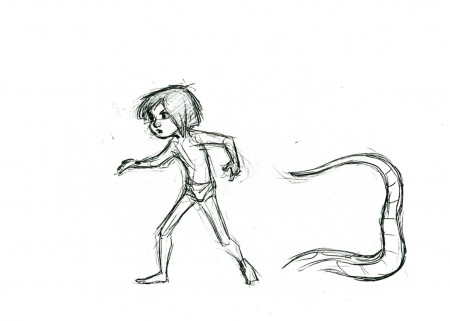 51
51(Click any image to enlarge to full animation sheet size.)
The QT movie below includes Parta 1, 2 &3 of this scene.
Mowgli & KaaClick left side of the black bar to play.
Right side to watch single frame.
Many thanks to John Canemaker for sharing these drawings with us.
Animation &Disney 12 Oct 2009 07:31 am
Frank Thomas’ Jungle Book 2
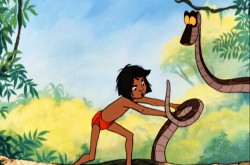 – We continue with Frank Thomas’ scene from the Jungle Book.
– We continue with Frank Thomas’ scene from the Jungle Book.
His animation is certainly a piece with the work he did on Sword in the Stone. I assume he did a large part of this show, as
he did with S in the St. These were very productive and fruitful years for Frank. It’s a shame the films didn’t have more depth.
This part of the scene starts on ones and soon goes to twos. Watching the QT movie, it all moves so fluidly that it all becomes solidly one.
To view the first Part of this scene go here.
I start off this scene with the last drawing from Part 1.
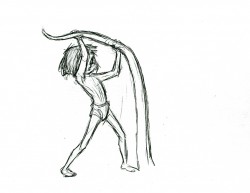 27
27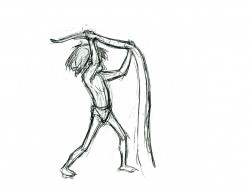 29
29(Click any image to enlarge to see the full animation page.
The QT movie below includes all drawings of this scene.
Mowgli & KaaClick left side of the black bar to play.
Right side to watch single frame.
The remainder of this scene will be posted next Monday, and the full QT will be made.
Animation &Animation Artifacts &Disney 05 Oct 2009 08:29 am
Frank Thomas’ Jungle Book 1
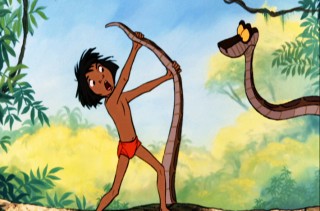 John Canemaker has loaned me a scene of drawings by Frank Thomas from the Jungle Book. Actually, they’re not the actual drawings but s/s xeroxed copies.
John Canemaker has loaned me a scene of drawings by Frank Thomas from the Jungle Book. Actually, they’re not the actual drawings but s/s xeroxed copies.
75 drawings in all, I’m going to post this scene between Mowgli and Kaa, the snake, however, I’ll have to break it up into a couple of posts. Here’s the first part, and I’ll follow up next Monday with more. Eventually we’ll post them all and have a QT movie of the full scene.
I’m not a fan of this film, however, I can’t deny the animation is mostly excellent and sometimes brilliant. Needless to say, Frank Thomas delivered some beautiful work. This scene is a typical example of his work even though it’s not one that calls attention to itself.
In studying the scene you might pay attention to what is on one’s (1-12) as opposed to what is on two’s (13-27) and figure out why.
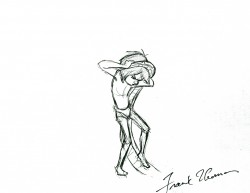 1
1 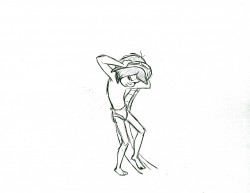 2
2(Click any image to enlarge to full animation paper size.)
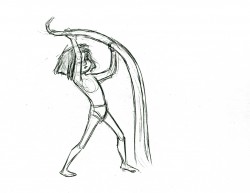 25
25 27
27
More to follow next Monday.
Here’s the QT of all the drawings from this scene.
Mowgli & Kaa
Click left side of the black bar to play.
Right side to watch single frame.
Animation &Bill Peckmann &Disney &Models &Story & Storyboards 28 Sep 2009 07:36 am
Bambi Board 2
- The cache of stats that Bill Peckmann recently sent me on loan includes several photo pages of storyboard from the Bambi Twitterpated sequence. I’m not much of a fan of this sequence, but looking at these beautiful storyboard drawings makes me realize how charming it is in its original state. The cute/cartoony movements came from the animators and directors. Perhaps the film needed this funny, broad approach, but I have a feeling there are other ways it could have been tackled that might have let it feel more connected to the whole.
As with past board postings, I’ve cut them up into rows so that I can post them at a higher res for better viewing. First here are the three pages as they stand:
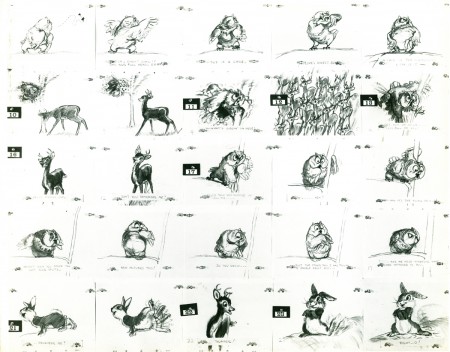 1
1(Click any image to enlarge.)
Now here they are again broken into individual rows:
 1a
1a
Here are some model sheets which relate to this sequence:
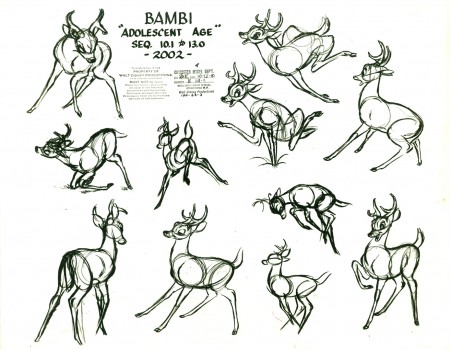 1
1
Once again, many thanks to Bill Peckmann for the loan of this marvelous material. It’s truly appreciated, and it’s fun to share.
It’s amazing to think how Walt Disney pushed all this great art forward. This film actually moved the “Art” side of animation forward with the majestic backgrounds, realistically designed animation and bold storytelling approach. There’s no possibility that something as rich as this film could be done today.
Animation &Disney &Frame Grabs 09 Sep 2009 07:43 am
Fantasia FX
- Herman Schultheis was an effects animator who worked on Fantasia. He kept a tight record of the effects they were creating from 1938-1941 and a photo display of how they were done. Schultheis disappeared in 1954 while trekking through Central America, and the notebook was forgotten until his wife’s death in the early 1990s, after which it was discovered by Howard Lowery behind the couple’s bedroom wall.
The book will be on display at the The Walt Disney Family Museum when it opens in October. It’s also been digitized so that visitors will be able to go through the book, enlarge photos and view it page by page.
Prior to the discovery of the book we were able to figure out a few of the effects. One Disneyland show, in fact, recreated the bubbling lava scene from the Rite of Spring sequence.
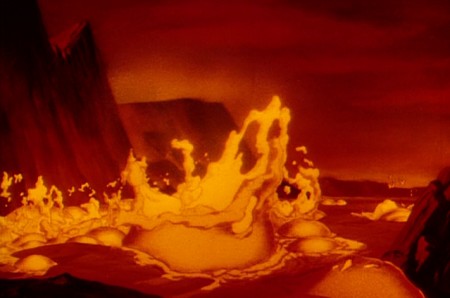
(Click any image to enlarge.)
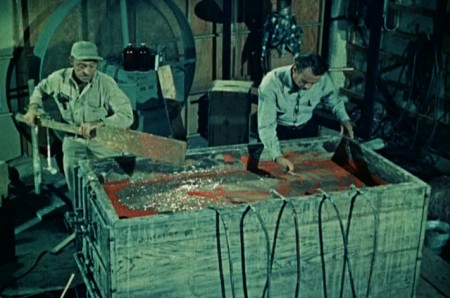
Josh Meador recreated the slow motion shoot of the
boiling concoction used to develop the bubbling lava.
However, the book revealed so much more than we’d understood
about how the superb effects had been crafted.
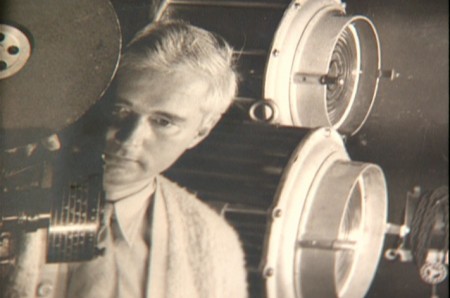
Herman Schultheis created the book of charts and photos
which gives us a link to the many creative effects in the film.
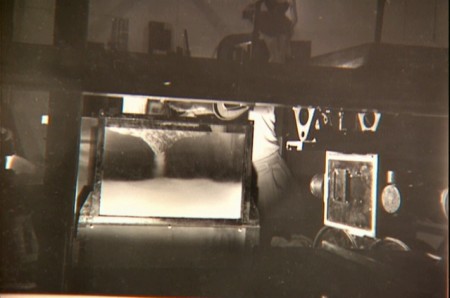
Using a vat of water, they were able to
drop ink into the liquid and film it in slow motion.
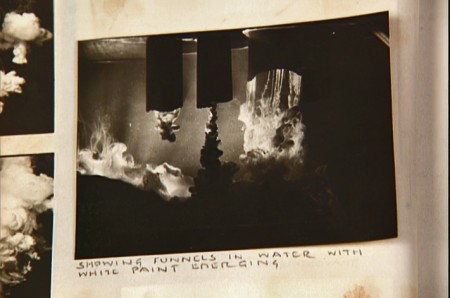
A photo of the ink spilling into the water behind built-in mattes.
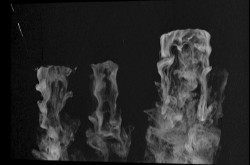
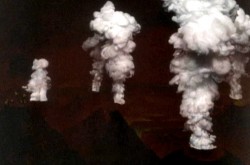
Taking the shot of the ink, they then turned it upside-down.
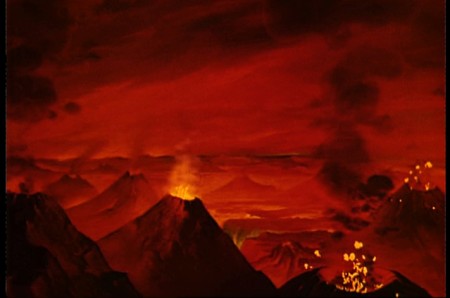
They then superimpose the “smoke” (or ink) over the volcanoes.
This same effect was used in Close Encounters of the Third Kind
to create clouds when the alien ships were moving in on the
farmhouse where the boy and mother lived.
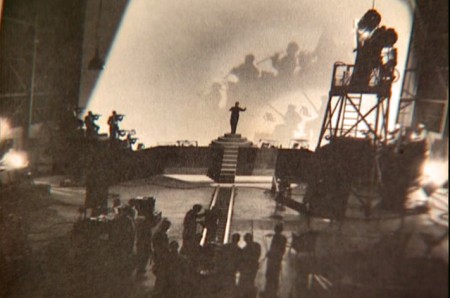
The orchestra was shot on a set with strong, planned shadows.
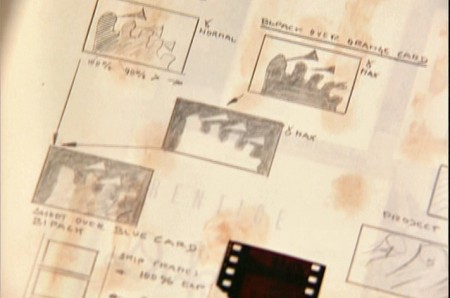
All these shots were orchestrated and planned for color effects.
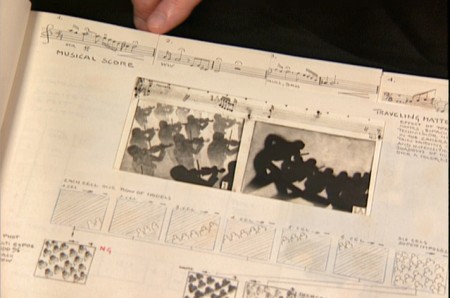
They were also catalogued by Schultheis who kept close
track of the music, as well, in his book. You can see a
page by page breakdown of the score at the top of the page.
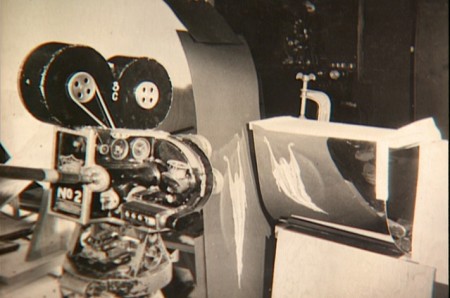
You can see the highly polished sheet of metal (middle left) which reflected
and distorted the animation drawings. This is what the camera photographed
in some of the scenes during the Night on Bald Mountain sequence.
It was also used for the fire in Bambi.
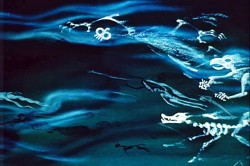 1
1 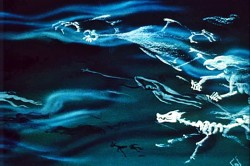 2
2
This scene’s ghosts were shot using that distorted metal reflection.
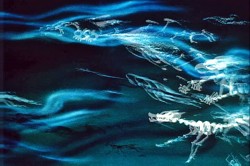 2a
2a 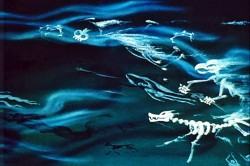 3
3
The ghosts also used a form of cross dissolve.
John Hubley explained to me how that was done.
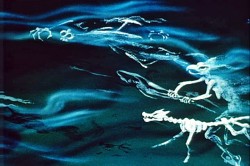 4
4 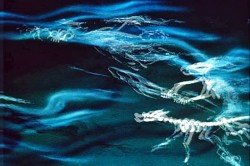 4a
4a
They shot the entire scene at 50% exposure. Then they went back
to the beginning and reshot the entire scene again at 50% exposure.
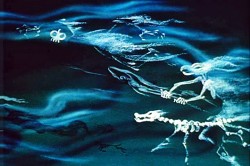 5
5 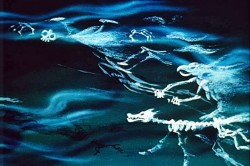 6
6
However on the second shoot, they started by shooting a black frame.
This made #1 fall where #2 should have been, #2 for #3 etc.
This creates a ghostly dissolve effect.
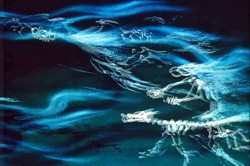 6a
6a 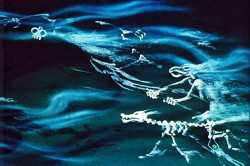 7
7
All of the drawings labelled with an “a” are the double exposures:
2a, 4a, 6a
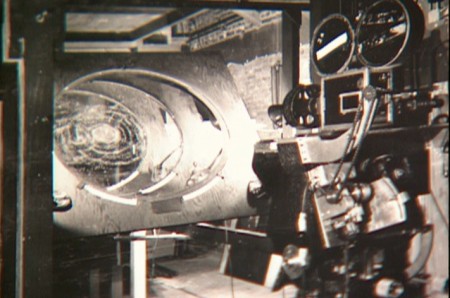
A make-shift circular multiplane camera was built.
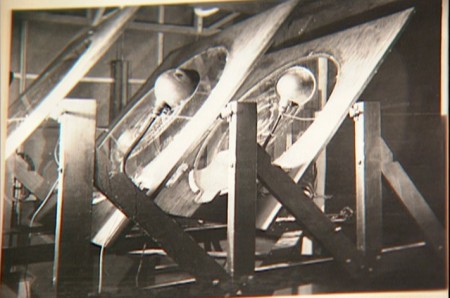
Created out of wooden sheets with holes cut out,
placed so they could shift angles, they were designed to
allow revolving artwork in the circular cut outs.
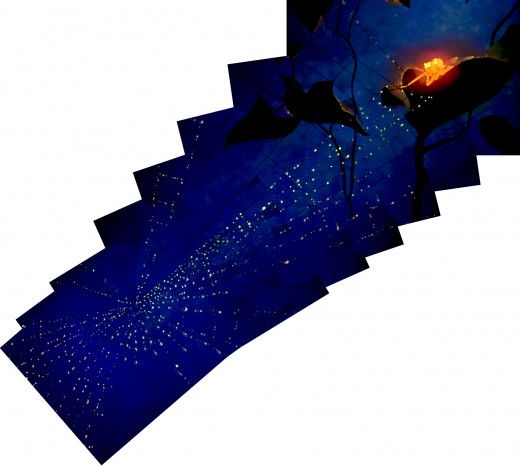
This allowed shooting scenes such as this shot of
a spider web as the camera turned around it while
dew glistened off it.
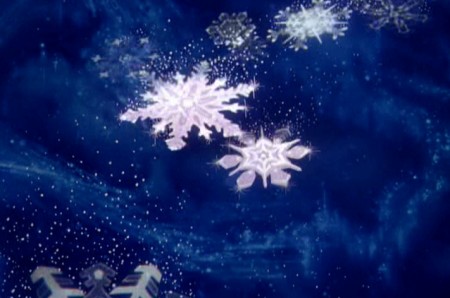
The spinning snowflakes are well explained in Schultheis’ book.
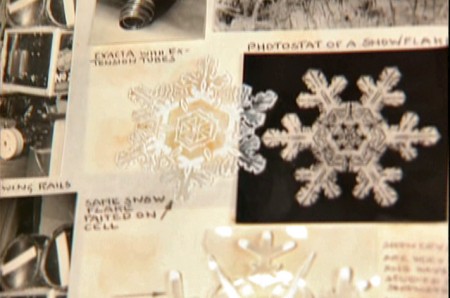
The snowflakes had a detailed construction.
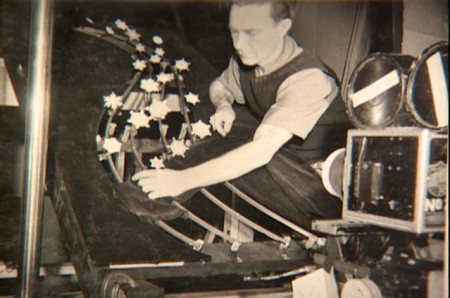
The path of action was intricately defined.
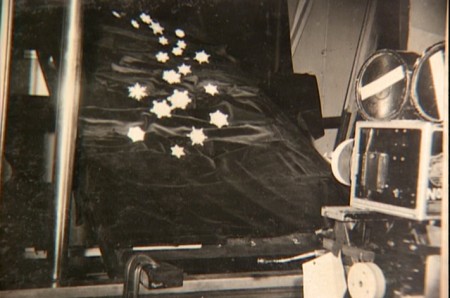
The snowflakes were shot against a sheet of black velvet
hiding the wire guides.
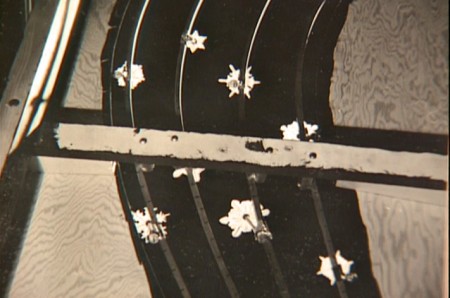
They were shot in tight closeup. From below you can
see the turning gears they were constructed on.
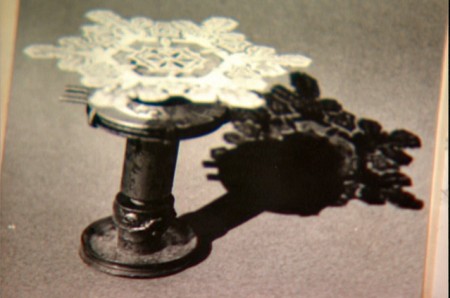
Each snowflake was built on a turning gear
so that they could revolve in their path of action.
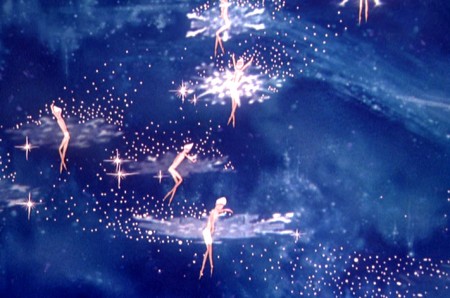
Burn these snowflakes over the multiplane background
and add matching 2D animated fairies within each snowflake,
and you have the finished scene.
Animation &Animation Artifacts &Richard Williams &walk cycle 28 Aug 2009 07:34 am
Babbitt Camel Run
- Art Babbitt supervised and animated large sections of Raggedy Ann & Andy featuring the Camel with the Wrinked Knees. He developed the character and gave it the form it finally took in the film. Other animators followed his directions throughout the film.
It was his idea to work the Camel as if there were two people within its body so that the front half didn’t always do what the back half did. As a result, runs and walks were usually peculiar. Often the front would move and the back half would have to catch up. Art never quite understood (nor did he try to understand) what other animators were doing with Ann and Andy. Consequently his version of these characters stood out like unconscious orbs floating around his camel.
Here’s a run cycle he did. The camel’s hind front leg is on another level as is his talking mouth.
The tight tight tight style is Art’s; the assisting is by David Block.
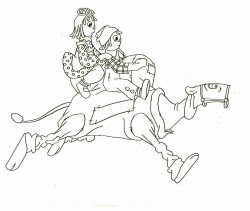 1
1 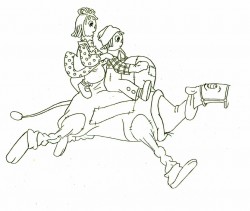 2
2(Click any image to enlarge.)
Here’s the final QT of it all together:
Babbitt’s Camel Run
Click left side of the black bar to play.
Right side to watch single frame.
Animation &Animation Artifacts &Hubley 03 Aug 2009 07:55 am
Hats & Fish
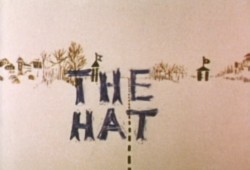 - Here are some drawings from the Hubley short, The Hat.
- Here are some drawings from the Hubley short, The Hat.
I first became aware of this short about the absurdity of border lines from a pre-PBS “educational TV” show on NY’s WNDT channel 13. Film critic Stanley Kaufman used to host a show called, “The Art of Film” in which he would have guests explaining their individual craft.
I can remember well a segment which featured composer, Elmer Bernstein, breaking down his music for The Magnificent 7. It was very informative and remains with me in memory to this day when I see the film.
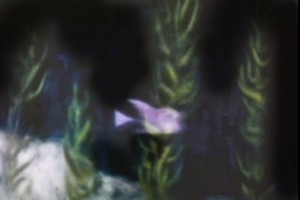 - John and Faith Hubley were on this show with drawings and storyboard and cels and Bgs from The Hat, then in production. I couldn’t have been more impressed and waited impatiently for about a year to see the film at the Beekman theater in NYC playing with Of Stars and Men.
- John and Faith Hubley were on this show with drawings and storyboard and cels and Bgs from The Hat, then in production. I couldn’t have been more impressed and waited impatiently for about a year to see the film at the Beekman theater in NYC playing with Of Stars and Men.
The style was one that John had been developing which had been successful for him. They would take the relatively clean animation drawings (done primarily here by Bill Littlejohn) and would paint them black. By that I mean, they would paint all the free space, outside the borders of the character, with black oil paint. (The oil paint didn’t stretch or buckle or shrink the paper. It just took forever to dry and destroyed the cells of the painters’ brains.)
The cameraman, Jack Buehre, would shoot the Background, then roll back the film and shoot the blackened characters as a double exposure. If there were more than one character it could mean several overlapping exposures.
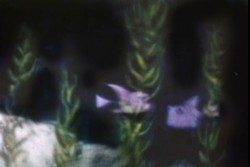
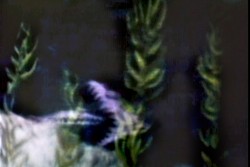
Here are examples of the animation in the final scene.
The exposure of the white drawings was shot at about 70%.
This allowed the characters to pick up some color from the dark violet
backgrounds. A ripple glass was also used over the drawings and bgs.
